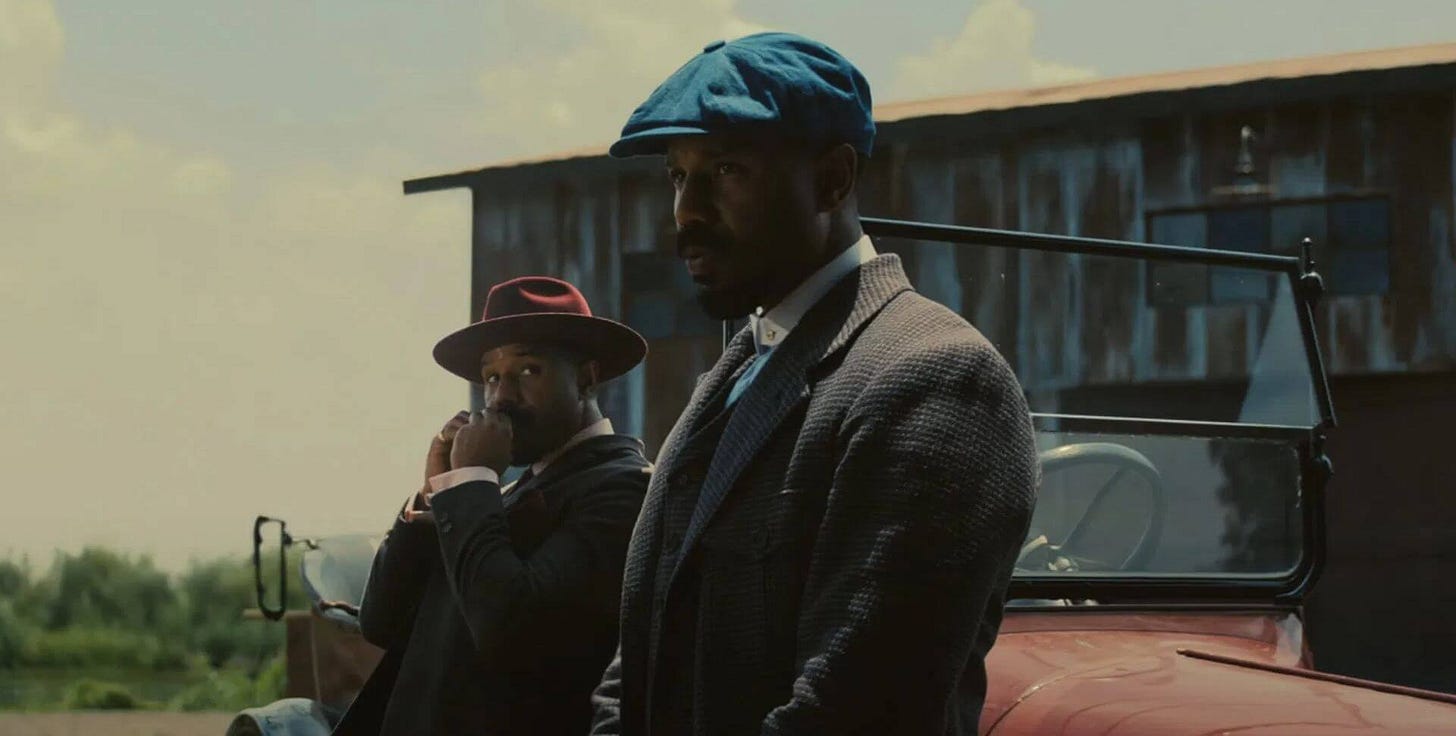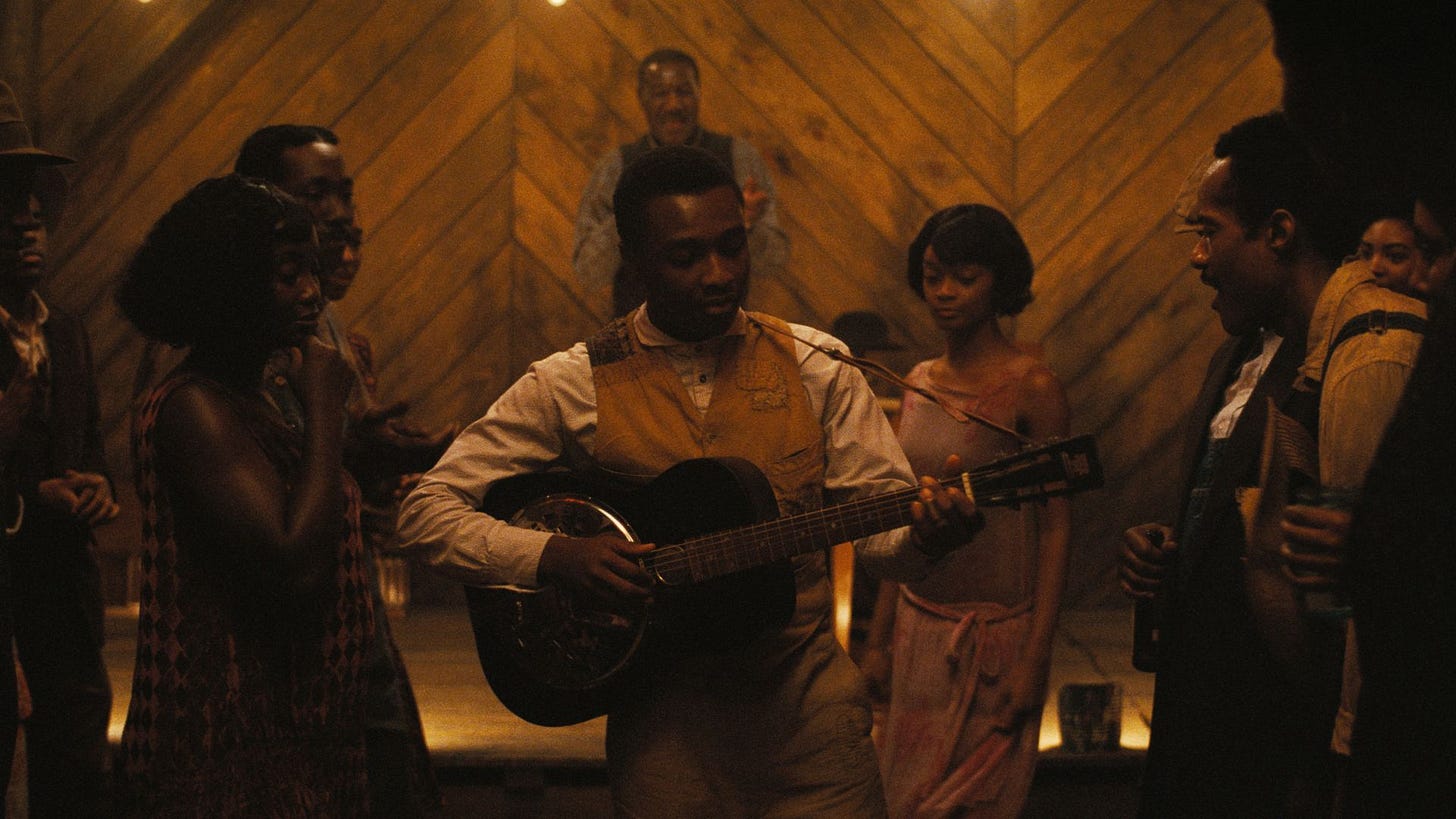Sinners (2025)
10/10
What a delight when a big, original movie lives up to the hype. After being underwhelmed by Mickey 17, I was careful to keep my expectations in check for Sinners despite rave reviews and record box-office holds indicating positive word of mouth. Happily, the movie surpassed my hopes on all fronts, with outstanding performances, music, cinematography, scares, drama, humour, and action. Writer-director Ryan Coogler has crafted a dazzlingly unique cinematic experience, mixing and matching different elements for something that feels fresh.
In a dual lead performance, Michael B. Jordan plays twins Smoke and Stack, First World War veterans who have recently returned to Clarkesville, Mississippi after getting mixed up with organized crime in Chicago. Purchasing an old sawmill from landowner and Ku Klux Klan leader Hogwood (David Moldanado) with money stolen from Chicago gangsters, they turn it into a juke joint for the local Black community. For their grand opening, the Smokestack twins recruit Smoke’s estranged wife Annie (Wunmi Mosaku) as a cook, musicians Sammie “Preacher Boy” Moore (Miles Caton)—the twins’ cousin—and Delta Slim (Delroy Lindo) as entertainers, married Chinese storeowners Bo (Yao) and Grace Chow (Li Jun Li) as suppliers, and sharecropper Cornbread (Omar Miller) as a bouncer. Singer Pearline (Jayme Lawson) also turns out for opening night along with Stack’s ex Mary (Hailee Steinfeld).
Events take a turn for the macabre after roving Irish vampire Remmick (Jack O’Connell) attacks local KKK couple Joan (Lola Kirke) and Bert (Peter Dreimanis) and transforms them into vampires themselves. Attracted by the noise at Smoke and Stack’s juke joint, they attempt to enter, offering to play some Irish folk tunes, but the twins are suspicious and rebuff them. Suffice to say that’s not the last they see of the vampires, and it ends up being one long night at the juke joint.
The term “elevated horror film” has become trendy lately to describe horror flicks that critics believe to be more respectable than the usual fare. If there’s one thing that can be said to elevate Sinners, it’s the music, which plays a central role here: specifically, the blues. With its 1932 setting in the Jim Crow-era South and Sammie the son of a preacher who warns him the blues is devil’s music, Sinners evokes legendary bluesman Robert Johnson, who was himself from Mississippi and famously said to have sold his soul to the devil in exchange for virtuoso skills on the guitar.
A standout sequence in Sinners shows Sammie’s musical performance summoning spirits from the past and future. Coogler depicts spirits ranging from a flashy ’70s funk guitarist to modern rappers and DJs to traditional African musicians and Chinese dancers, integrating their music and movements into the blues Sammie is playing and the dancing of the crowd. Most of the music in Sinnners is old-school blues, aside from some beautiful Irish folk music. Ludwig Göransson’s fantastic score takes inspiration from the blues, from raw acoustic Delta blues to later electric variants, mixing these with electronic and hip-hop textures and ominous choirs. The intermingling of blues with other styles reinforces the idea of these spirits and vampires being immortal creatures beyond time.
Racism is a major theme, unavoidably so given the film’s setting. We’re constantly reminded of the racism that is a constant and unavoidable fact of life for Black Americans under Jim Crow, from Hogwood calling the Smokestack twins “boys” to segregated washrooms to the ever-present threat of lynching and the KKK. But as the twins remark, things aren’t much better in the North, where most venues are de facto segregated. As it has for generations of Black musicians, music offers an escape from racism, and the juke joint a place where patrons can momentarily forget the oppression and injustice of the outside world.
Moreover, society’s racism empowers the vampires. Traditionally, vampire fiction has included an element of seduction, as we see in Dracula films where women almost invitingly bare their necks to the count. Sinners offers a different kind of seduction, promising immortality and freedom from racism. Say what you will about the vampires here, but they’re not racist. Aside from the little matter of wanting to feed on people’s blood, the KKK couple, for example, if anything become better people after they turn into vampires. In stark contrast to the racial divisions that define life in the South, after the vampires start converting juke joint patrons, we have the sight of Black sharecroppers, Chinese immigrants, and KKK members dancing and singing together to traditional Irish music.
Characters are a further strength of Sinners. Coogler takes the time to set up both the Smokestack twins and the supporting cast, giving them distinctive back stories and personalities that make the audience more invested in their fate. Annie’s occult beliefs render her the chief vampire expert when it becomes clear what’s going on, and she advises everyone to arm themselves with the traditional accoutrements: garlic, holy water, wooden stakes.
Coogler takes so much time setting up the characters that the vampire attack and action scenes, when they come, almost feels like a jarring tonal shift to a film that hitherto had been mostly realistic. In my view, though, the writer-director provides enough buildup for those elements: from the opening scene describing occult beliefs in various folk traditions, to jump scares and warnings from Choctaw vampire hunters and Sammie’s pastor father Jedidiah (Saul Williams), to Remmick’s first attack with glowing red eyes, fangs, and blood-drenched smile. Despite exploring serious themes like racism, Sinners includes its share of laugh-out-loud humour, which makes the action and inherently fantastic nature of a vampire story go down easier.
Sinners offers not just music for the ears, but a feast for the eyes. The film is gorgeously shot by cinematographer Autumn Durald Arkapaw and includes numerous loving depictions of the Mississippi landscape. Period costumes and production design are top-notch. All of the cast offer strong performances, led by Jordan, who brings much charisma to Smoke and Stack. Caton is a great find in his first major film role; it’s stunning that he only had two months after signing on to learn how to play the blues guitar. A cameo by blues legend Buddy Guy is icing on the cake.
If there’s one complaint I have about Sinners, it’s that the movie ends abruptly and rolls credits before a five-minute mid-credits scene, which represents the real ending to the film. Post-credit scenes are out of control in our post-MCU world and we need a moratorium on them for a while. There were plenty of people at my screening who left when the credits started rolling and missed the actual ending. This quibble aside, Sinners is the best experience I’ve had at the movies since Dune: Part Two. Here’s hoping its success leads Hollywood to greenlight more original films.







